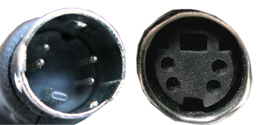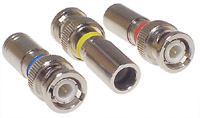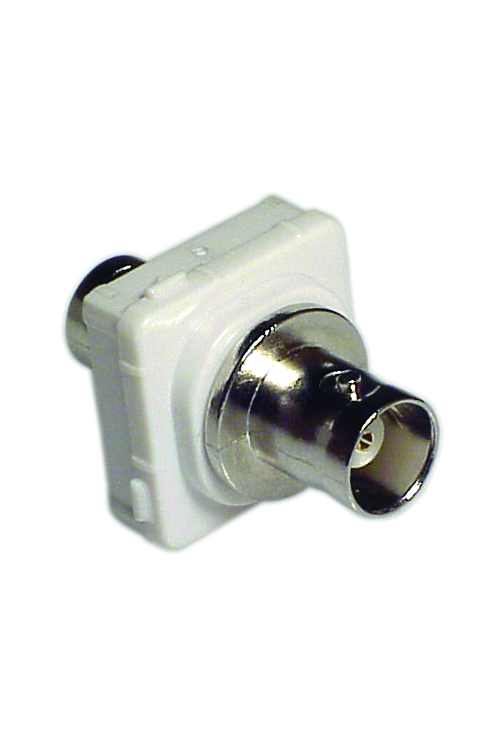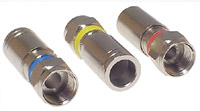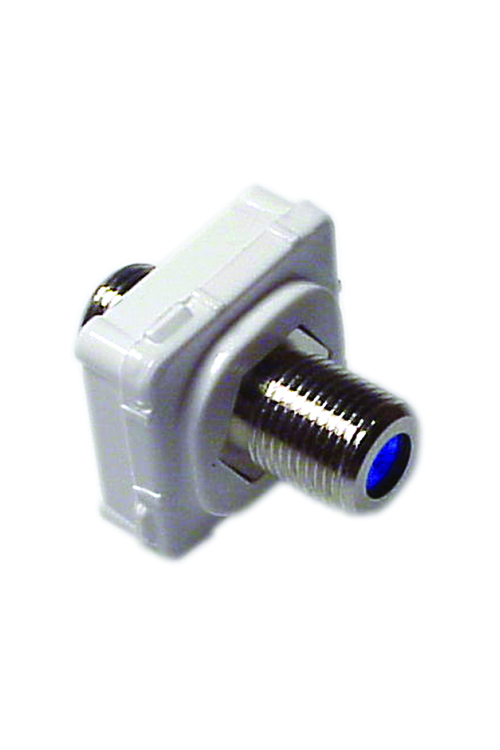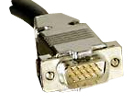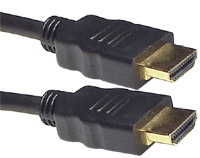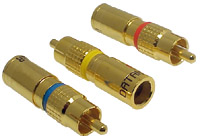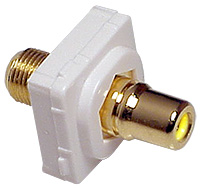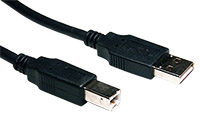4-Pin Mini Din
Very common on consumer audio/video gear. Carries an S-video signal (also referred to as S-VHS on older VCRs. The cable consists of twin coaxial cables in a common sheath.
Belling Lee
(see PAL)
BNC
Used for video signals and labeled similarly to RCA. Used to carry Composite video (one connection), S-video (two connections), Y/Pb/Pr (three connections), or one of the RGB variants.
DVI
There are 3 types of Digital Video Interface connector (DVI-A, DVI-D and DVI-I) as detailed below. DVI-D and DVI-I are available in either single-link or dual-link types. In the pictures below, the single-link socket is shown on top of the corresponding dual-link socket. Most manufacturers make their female plugs with all available pins to prevent pin damage if an incorrect cable is inserted.
DVI-A
![]()
Carries signals to an analogue display only. Has two pins above\and two pins below the flat-bladed pin (shown on the left-hand\side of the\picture) that are used for the analogue signal. The right-hand side has 8-pin & 4-pin separated pin-sets.
DVI-D
![]()
Used for digital signals only. Has three rows of 6 pins or three rows of eight pins on the right-hand side and no pins above or below the flat-bladed pin on the left-hand side.
DVI-I
![]()
Refers to a connector type which combines DVI-A and DVI-D with pins provided to carry either an analogue or digital video signal. A DVI-I cable can therefore be used either for a digital signal (in a DVI-I socket) or for an analogue signal (in a DVI-A socket). Because of the extra pins, they cannot physically fit into a DVI-D socket. Has three rows of 6 pins or three rows of eight pins on the right-hand side with two pins above and two pins below the flat-bladed pin on the left-hand side.
EIJA OPTICAL
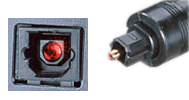
Commonly called "TOSLINK" (Toshiba Link). These cables/connectors are used for digital audio using light from an LED "transmitter" as the source.
EURO CONNECTOR
(see SCART)
F-Type Connector (F-81)
Used for most antenna and cable TV connections being rarely used for anything other than RF with one notable exception when they were used as digital audio connectors on some laser disc players.
Firewire
(see IEEE1394). Apple's® trademarked name for the IEEE1394 standard.
DE-15 / VGA / HD15 / D-Sub 15 /
As used on LCD and Plasma displays and computer monitors for RGBHV signals. Also used for RGBS, RGB sync-on-green, and Y/Pb/Pr Component video.
HDMI
HDMI (High Definition Media Interface) connectors are used for digital connections between the audio/video source and audio/video monitor or equipment, combining a digital audio and a digital video cable into a single connector. Found on DVD players/recorders, Plasma & LCD displays and digital surround-sound amplifiers & receivers.
IEEE1394
![]()
Widely used for digital video and audio for DV (Digital Video)in cameras, DVD recorders and PCs. The 6-pin connector has twin separately shielded twisted data pairs for transmission/reception of data signals plus two power conductors. The smaller 4-pin connector has only two data pairs and is used primarily with battery-powered devices.
I-Link
(see IEEE1394). Sony's® proprietary name for the IEEE1394 standard.
PAL
PAL (Belling Lee) connectors are a push-on connector that have been traditionally used for TV antenna wall plates andconnections. With the exception of TV/VCR hook-ups, PAL connectors are being replaced by F-Type connectors as required for CATV, SATV and DTV. PAL connectors are specified by IEC standard IEC60169-2.
PERITEL
(see SCART)
PHONO JACKS/PLUGS
Common stereo (3-wire tip/ring/sleeve) connectors providing a balanced circuit for analogue audio such as inputs/outputs to equipment and peripheral devices like headsets. There is also a mono (2-wire tip/sleeve) version which is used for unbalanced circuits. Standard sizes are 6.3mm, 3.5mm (mini phono) and 2.5mm (sub-mini phono).
RCA
The RCA is the most common connector type on consumer gear for composite and component video, as well as for both digital and analogue audio. RCA jacks color-coded yellow on a device usually are composite video inputs or outputs.
SCART

SCART (Sydicat des Constructeurs d'Appareils Radiorécepteurs et Téléviseurs) connectors are used to connect audio and video equipment using the Composite Video signal format
S-VHS
(see 4-pin Mini Din)
S-Video
(see 4-pin Mini Din)
TOSLINK
(see EIJA Optical)
USB Type-A, USB Type-B
A 4-wire cable carring 2 power and 2 data connections to transfer digital information between computers, personal music/video players, cameras etc. The cable is terminated with type-A, type-B or a combination of A and B USB connectors.
XLR

A three-pin balanced audio connector. Typically used for microphone cables.
Our cables reference page to identify the different cable types commonly used for audio/video installations. Our suggested color code for audio/video interconnects that identifies the role of a particular cable, is based on common industry practice. Our signals reference page explains the different audio/video signal protocols in common use.
Shop Our Range Today!
Explore our extensive range of Network and Data Cables, Power Cords, Power Supplies, Server Racks & Accessories, Tools and Test Equipment designed to meed your data, security and communication needs.
Experience the Access Advantage
Elevate your data, security, and communications solutions with Access Communications. Our unwavering commitment to quality, expertise, and innovation sets us apart as Australia's premier supplier. With over four decades of trusted service, we offer an extensive range of products tailored to your diverse needs.
Why Choose Access?
- Quality Assurance: Rigorous testing ensures excellence in every product.
- Expertise: Benefit from 50 years of industry knowledge and personalised service.
- Extensive Range: Find solutions for all your requirements, from network cables to custom assemblies.
- Customisation: Tailored solutions to fit your unique specifications.
- Forward-Thinking: Stay ahead with innovative products designed for the future.
- Unmatched Service: Experience unparalleled support and dedication to your success.
Join the thousands who trust Access Communications for their data, security, and communications needs. Explore our offerings and discover the Access Advantage today!

